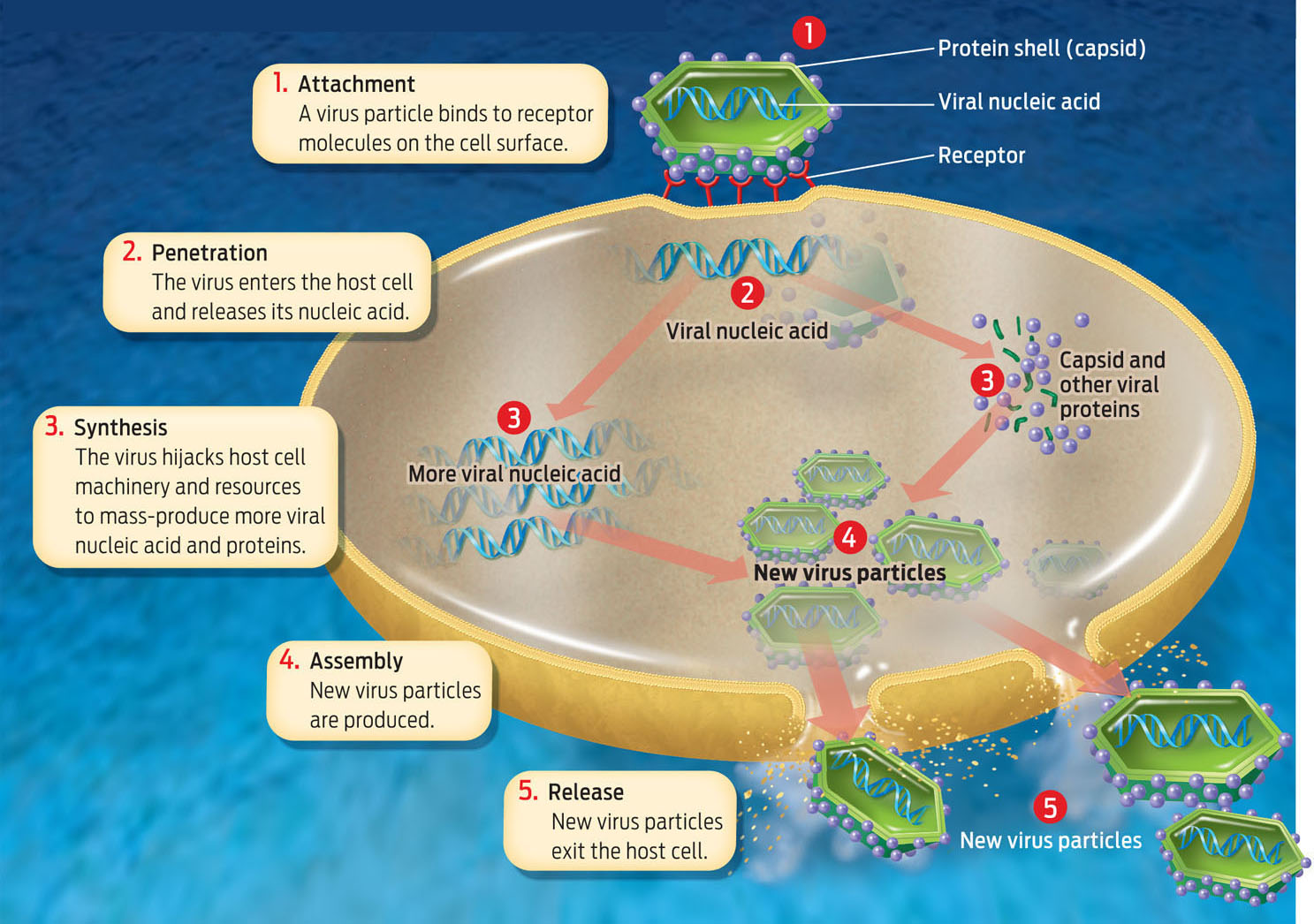SILENT INVADER
Each year in the United States about 36,000 people die from flu-related complications, and more than 200,000 people are hospitalized from flu-related illnesses. Most of these deaths strike young children and the elderly, whose bodies are less able to fight off the infection. The 1918 flu, by contrast, struck down people in the prime of life: people age 20 to 40 were the hardest hit. The death toll in this age group was so severe that it reduced the average U.S. life expectancy for that year by 12 years.
Virus An acellular infectious particle consisting of nucleic acid surrounded by a protein shell.
693
At the time, doctors did not know what caused influenza. Some suspected that it was caused by a bacterium–as were many other known diseases, such as cholera and tuberculosis. But research in 1933 showed that influenza is caused not by a bacterium but by a virus.
The influenza virus, like all viruses, is a particle made up of nucleic acid surrounded by a protein shell. The nucleic acid serves as the virus’s genetic material, while the protein shell (called a capsid) allows the virus to bind to and enter cells. Viruses are considered to be nonliving because even though all viruses have genes, viruses are not made of cells. Because they don’t have cells, viruses can reproduce only by infecting host cells. They then use the host cell’s machinery to replicate and make more viruses. Eventually they destroy the host cell (INFOGRAPHIC 31.1).
Viruses can replicate only within a host cell. Viral genes direct the host cell to synthesize new viral particles. Ultimately, viral replication kills the host cell either by causing it to burst or by depleting the cell’s resources.

Unlike cells, which rely on DNA as their hereditary material, viruses can store their genetic information in the form of either DNA or RNA (see Chapter 2). RNA viruses include the influenza virus and the viruses that cause colds, measles, and mumps. RNA viruses also cause more serious diseases, like AIDS and polio. Diseases caused by DNA viruses include hepatitis B, chicken pox, and herpes. Each type of virus has a characteristic shape and a distinctive protein shell.
694
We didn’t take temperatures; we didn’t even have time to take blood pressure. We would give them a little hot whisky toddy; that’s about all we had time to do.
— JOSIE BROWN, a nurse stationed at a naval base in Illinois in 1918
IMMUNE SYSTEM A system of cells and tissues that acts to defend the body against foreign cells and infectious agents.
Some viruses cause more damage than others. The severity of any illness typically depends on how quickly the immune system responds and how well the infected tissue can repair itself. Most people recover completely from the rhinovirus that causes the common cold because the respiratory tract contains rapidly dividing cells that quickly replace damaged ones. Poliovirus, however, attacks nerve cells that almost never divide, which is why polio infection may cause paralysis.
Like the virus that causes common colds, the flu virus spreads from person to person through coughs and sneezes. Viruses are extremely small and are easily aerosolized. One sneeze can send millions of virus particles out into the air, where they are free to infect other victims who are near enough to inhale them. Only one or two particles are enough to cause an infection.
Scientists aren’t sure where the 1918 flu outbreak started. Newspaper coverage of the carnage first occurred in Spain, which was a neutral country in World War I and one where news was not censored. For that reason, the pandemic became known at the time as “Spanish flu.” However, we now know that the virus did not start in Spain, and that some of the earliest reported cases occurred in the United States, among soldiers housed in close quarters. Such U.S. military bases were also where Spanish flu first demonstrated its deadly power.
“We didn’t have the time to treat them,” recalled Josie Brown, a nurse stationed at a naval base in Illinois in 1918. “We didn’t take temperatures; we didn’t even have time to take blood pressure. We would give them a little hot whisky toddy; that’s about all we had time to do.”